Meidjo updates -17jan15
“Ask and you shall receive,” goes the saying. We all know that isn’t always true, but it is often enough to keep the quip alive. In this case, it is true. For years tech savvy telemarkers have dreamed of a lightweight binding with Dynafit touring efficiency and a powerful NTN connection to the boot. With the delivery of Meidjo, the first design from French manufacturer the M-Equipment, the brainchild of Pierre Mouyade, that day has arrived.
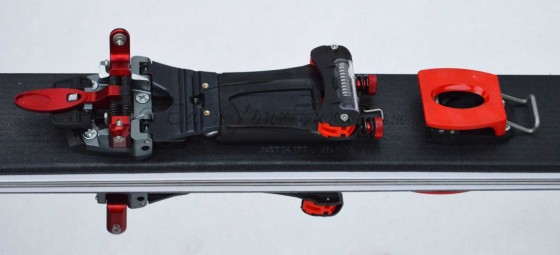
Meidjo: < 1 lb./binding, free-pivot, NTN compatible, step-in, releasable, and powerful.
Requires 1) Faith in the 2-pin tech toe and 2) an early adopter license.
Last spring a video of a prototype telemark binding began circulating on the internet showing a binding with a low-tech toe and a spring-loaded plate that attached to the 2nd heel of a Scarpa TX-Pro. Skepticism ran as high as optimism for two reasons. First, that it would make it to market as early as claimed, by late 2014, and two, that it would ski very well. The first production bindings were delivered in December 2014, fulfilling the delivery claim. After a mere two short tours I can verify, it skis as well as promised, both uphill and downhill.
My first impression of Meidjo was of surprise at how professional it looked and felt. Over the years I’ve become accustomed to spartan simplicity, not just in the look and functionality of telemark bindings, but in their presentation. Meidjo came in a box with a classy looking illustration of the binding on the outside, and a well organized presentation of the pieces inside. This binding was clearly a well crafted piece of engineering with molded parts and plenty of attention paid to the details. While some pieces of the product are currently missing, such as ski brakes or crampons, their future inclusion has already been accounted for even in this first generation version.
The Low-Tech Toepiece
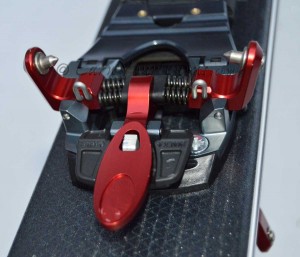
Meidjo’s low-tech toe has alignment bumpers and stands 2mm higher than other tech pins with true lock out for touring.
To account for different thickness soles of NTN boots the height of the toe pins are 2mm higher than classic Dynafit pins, so the lugged soles of thicker boots won’t contact the base of the toe plate and interfere with release.
When touring, the jaws can be locked shut, not by pulling up on the metal bar in front, but by pushing down on a plastic piece that moves a metal tab under the release bar preventing it from moving down and opening the pin jaws. The beauty of this system is two-fold. First, you switch between walk or tele modes using your ski pole, without having to bend over. Secondly, it doesn’t just increase the resistance to opening, it prevents the jaws opening. In my maiden tour I was traversing icy slopes that mandated repeated stomping. I released only once, because I had forgotten to lock the jaws shut. Once locked, they stayed shut, even with repeated, aggressive stomping to hold an edge.
Step-In
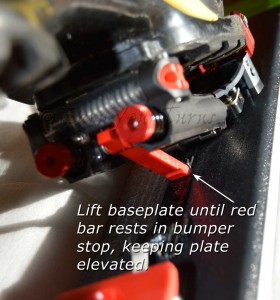
To step in, first cock the baseplate into position by lifting it until the red bar seats in the bumper.
Downhill Power
As yet I haven’t done a true side-by-side comparison but experience suggests the Meidjo is equivalent to HH#3 or 3½. Not the most active binding available, but no slouch either and probably the activity level that most telemarkers prefer. It is certainly active enough to hold a solid edge on hard pack, and not so active that it will cause excessive tip dive in soft snow. The actual cable pivot position is about 60mm behind the toe pins, which is approximately the same as the forward position of a TTS binding.
While the pivot location of the “cable” is fixed, you can increase spring tension simply by tightening the lugs holding the springs on the cable bar. When I say Meidjo has a tension of approximately HH#3, that is for a lightly tensioned spring, or a setting of 2 out of 5 per Meidjo’s scale. If you want even more tele-resistance, a second set of springs is available that can be added in parallel (inside) the stock springs to increase the baseline activity of telemark tension.
Safety Release
In theory Meidjo offers a safety release, a combination of an adjustable spring tension on the side wings that hold the second heel, and the spring tension of the pins. In my limited number of runs I did not experience any release, nor should I have. At this moment it certainly isn’t certified, but like most telemark binding release systems, probably works. I can confirm it did release laterally with a kick from the side aimed at the back of the boot. In due time reports from the field will confirm or deny the “safety” aspect of Meidjo’s release system. The release tension is adjustable with a 3mm allen wrench to increase or decrease spring tension on the wings holding the sides of the duckbutt.
Exiting the binding
As with nearly any other tech binding, press the front toe lever down to open the jaws. Lift the toe of your boot a bit, then twist it to unhook the duckbutt from the binding plate.
Touring Efficiency
As you might expect, with a 2-pin tech toe this is a very efficient binding for skinning since you only lift your boot when striding. However, to lock the plate out of the way so it doesn’t flop around or inadvertently latch onto your boot you must hook a wire over the central red bar to hold the plate down. This is a small wire hoop that requires finger dexterity to move. Not a big deal, except it means you must exit the binding to latch the plate flat, but you needed to do that to put your skins on anyway, right? To unhook the plate when you’re ready to rip the hide and make some turns Meidjo provides some tape to attach to the wire hoop so you can pull it back and release it. Except the tape is weak and mine tore the very first time. A better mousetrap is in the works for this function, but in the meantime I suggest substituting a strip of fiberglass reinforced strapping tape (Scotch brand 893-JPK) that is stronger and will last longer.
At just under 1 pound per foot (430 g or 15.2 oz/foot, size Lg), you’ll love how little this binding adds to your total drag weight.
The heel post is one of the weak ingredients of this binding. It is a simple plastic post that flips up easily with your ski pole to provide an angle of 7° or, flip up a secondary wire for a higher climbing angle of 13°. These are pretty common heights, but unfortunately, the posts are prone to collapsing under pressure. A cure is in the works, but not available at the moment. In the short term, consider making peace with a low-angle, meanderthal skin track. 😉
Mounting
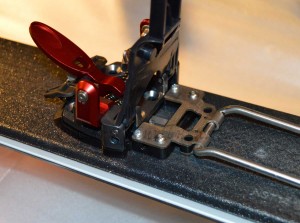
To access the rear mounting holes the baseplate must be partially disassembled.
Hint: When reassembling, it is easier to thread the spring tensioning knobs on when the baseplate is flat.
Equally important is reviewing all the pieces of the binding because some assembly IS required and you need to understand where each part goes before you start drilling and screwing things together, hopefully in proper sequence and position, not screwing them up. The English directions are clearly a translation so you are advised to proceed with caution. If you’re not mechanically inclined, find someone who is to mount Meidjo for you.
Caveats
As this is a first look at a first generation binding many, if not all, the issues raised below will inevitably cease to be a concern in succeeding generations of this binding. For the moment, they are valid.
Although Meidjo does not yet offer ski brakes the holes to attach them to the binding already exist. They’re located between the cable pivot and the toepiece. These are scheduled to be available later this season.
Likewise for ski crampons. There is a set of brass inserts on top of the plate, just behind the cable pivot where a crampon clip will be attached. The clip will work with Dynafit compatible crampons.
For those on the Wet Coast, some icing is bound to occur. So far the only icing I noticed was snow packing in the cavity where the 2nd heel sits, which prevents switching from tour to tele mode without taking a moment to clear it out. It might mean you have to step out of the binding before you can step back in. Expect a round of heckling from your friends with Switchbacks.
The stainless steel toe pins of tech bindings are typically pressed into the arms or jaws of the toe piece. In the current version of Meidjo the pins fit tight, but are actually held with epoxy around their circumference plus a snap ring on the outside. Next years production run will be press fit like other tech bindings.
It is also worth noting the pins do not have ice cutting slots in them. Whether those will be added sooner or later remains to be seen. They aren’t on all tech bindings, but most.
Fixed
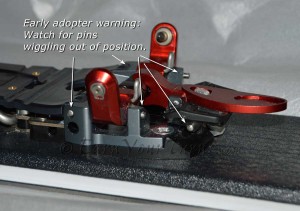
Until next the production run, keep your eye on the pins that hold the toe jaws, the base plate, and the mode switch.
Fixed
The durability of the baseplate is categorically suspect because of its plastic composition. It looks well made but only time will tell if it can go the distance.
Conclusion
If you’ve been holding out on upgrading your duckbilled telemark rig to the duckbutted NTN because it didn’t offer any clear advantages, the arrival of Meidjo is about to change that. Admittedly it needs a tweak or two but even at birth it offers excellent skiing performance, superb touring efficiency thanks to a 2-pin tech toe and seriously light weight, plus step-in convenience and even (albeit unproven, uncertified) safety release. Now, if you also want a lower price you’ll have to be content with what you have a while longer. Actually, when you consider that heavier tech bindings are about the same price, but they don’t tele for squat, the price is competitive. If you’re ready to embrace the future, and can afford the bruises that come on the bleeding edge of innovation, the future of tele is here today.
M-Equipment
Meidjo
MSRP: ~ $550* (€449)
Weight/binding (sz Lg): 15.2 oz. (430 g)
* – based on $ to € exchange rate on 05Jan15.
Related Posts
BCTalk discussion on Meidjo
© 2015

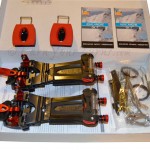

17 comments
1 ping
Skip to comment form
Thanks Dostie,
Great review and a binding with a lot of potential..
How will we pronounce the name on this side of the pond? Meet-Joe, Me-yo?
Looks like what I’ve been waiting for. It it only included brakes it would tick off every box on my list (although I hear those are coming soon).
Did M Equipment have to licence the NTN from Rotefella like 22 Designs or this this binding different enough to avoid that? With all the new telemark bindings coming out it proves your past article that telemark is neither dead or stupid!
Meidjo is pronounced may’-zho, with a lil’ francois spin. 😉 It comes from Le Meij which is the designer’s fave BC destination and means the pinnacle, or zenith since the sun is at its highest point in the sky directly above Le Meij, at midday.
very cool- I’m thinking these could be my next touring bindings when the Freedoms wear out!
Thanks for the review. An plans on a follow up review once you get some more days on them
Absotively. Not just more days by moi, but when I have more input from other users besides myself. The pin issue was caught by MikeMM on BCTalk. Plus there will be incremental improvements and additions (like ski brakes) so a review that includes more time and abuse will be a natural follow up. Am hoping to be able to say some weaknesses have been resolved and no longer exist.
Looking very nice. The one part I hope does get worked out is being able to keep the ski on to switch into tour mode. Yes to apply skins you generally need to remove the ski, but for patterned bases or kick wax when you don’t need the grip of a skin, switching modes should be almost effortless.
CNC alloy wings? We have seen over the years that cnc wings can be a problem with fatigue. with all thats going on there, I would think they would go cast.
Interesting how the Meidjo uses the same specie under-the-boot plastic hinge as my beloved 7tm tour. Hope they spoke to Karhu to see how that worked for them! Gary hollenbaugh
Hello all,
I was fortunate enough to be able test out the new M-equipe binding for 2 days earlier this week and thoroughly enjoyed it. I have been using the NTN system now for years and it was great to ride a new option with this technology.
The binding looks almost identical to the CAT rendition and is pretty slick. Fantastic weight underfoot without having to sacrifice downhill performance. the entry/exit interface only took one try to figure it out and is actually quite intuitive.
I didn’t have the opportunity to increase the amount of resistance in the binding, so I’m definitely curious to try that out next time around, yet will say that the system delivers a little more power than Rottefella’s Freedom binding. It’s not an overtly noticeable difference in performance, but noticeable just the same.
Overall a great new addition to the market and i am fired up to ride even more options in the not too distant future.
Thanks D
P.S i spent the last 2 days on the new Outlaws… :0
Thanks for the review! Nice to hear what others think about this binding as well. I’ve had one day on the slopes so far and downhill I can’t complain in any way, they are great! After adding the extra springs inside the original ones I feel the Meidjo compares well to 2nd position axl (maybe I’m fooled by changing boots as well…), which suits me well.
The BIG issue I have is uphill (the one thing I really thought would work!); at the slightest touch of hard snow or ice the toe-piece flexes and I lose the ski. This is even with the toe-piece locked (I’ve quadruple-checked this). It seems the construction flexes such that I’m able to escape the pins without the toe-piece releasing, it is locked also afterwards. Touring is paramount to this binding so I am very disappointed at the moment and can’t recommend it to anyone who plan on earning their turns…
Heard that same report from another, which will be posted as a Page 2 addendum to this review. Guess my experience of not having the toe pins let go is the exception, not the rule. Have also seen and heard of the plastic baseplate cracking. So I think there are some QC issues that need to be dealt with and when they have been, then I think this will be a very in-demand binding. As with all first year bindings, there’s a lot of beta to be obtained before it’s no longer in beta mode. 😉
There are other folks posting their experiences at the link to the BCTalk forum, at the bottom of the review (above).
Yeah I read it on BCTalk as well. You’re definitely right, these bindings will be in very high demand when they fix the quality issues, and my recommendation is of course based on the state my current bindings are in i.e. not usable for touring. I hope this really is a QC- and not a construction issue. We’ll see how T-P and M-equipment handle returns and complaints 🙂
There are a number of fixes in the works for Meidjo, available within a few weeks. A full update as soon as I stop traveling long enough to put it all together. In brief, the problem with the jaws opening, even while locked, has been identified and fixed. Same for the plastic baseplate breaking. And another issue so many telemarkers are familiar with, screws pulling out at the back of the binding. If you’ve had trouble, contact your retailer or M-Equipment to arrange an exchange.
I just received a pair in the mail, thought I would get ahead of the game like many of you but I have to say I am a little dismayed at the lack of instructions (mounting and use) in the box. Ok, so the extra springs are meant to slot inside pre-existing black ones. So far so good. What about those two metal bracket/plates that come included in the screw/goodie bag. What are those for? Any mounting tips from you all? Thanks in advance.
Ivan, A Frustrated Newbie (to MEIDJO)
[…] At least two people have noticed this. In the comments to the First Look review, Mathias said, “The BIG issue I have is uphill (the one thing I really thought would work!); at […]